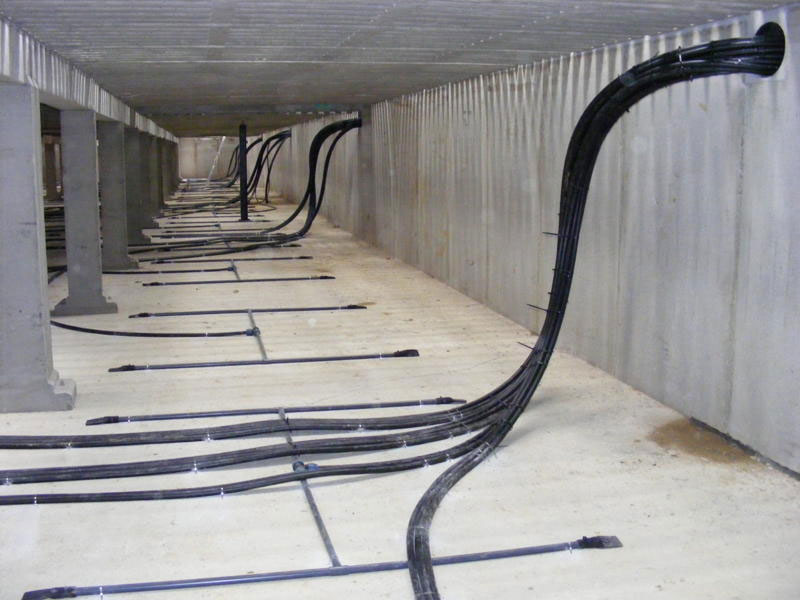
As intensive livestock production has continued to evolve, so have strategies for the storage and utilization of the resulting manure. No longer considered a “by-product” of the operation, manure has proven its value to the farmer. Manure acts as a replacement for commercial fertilizer and offers a source of organic material, resulting in improved consistency of soil quality and crop yields. Recent technological advances in manure storage and management have focused on improving the value and reducing the cost of the processes involved.
Historically, the storage of liquid swine and cattle manure has incorporated either a lagoon, tank, or pit design within which manure is held until it can be applied to cropland. Such storage methods have some inherent limitations, such as inconsistency of dilution, homogeneity of the slurry, and the resulting variation in nutrient availability and value. Conventional pit storage systems generally utilize an anaerobic (without the involvement of oxygen) process whereby decomposition of organic compounds results in the emission of methane gas and carbon dioxide.
Recently, there has been an increase in the awareness and utilization of manure aeration technology that incorporates an “aerobic” process that supplies enough oxygen to support aerobic bacteria. While historically, the capital and operating costs of aeration systems have been seen as cost-prohibitive, although advances in the design and components used in today’s systems have demonstrated the potential to offer an attractive return on investment, in addition to improved odor control and net manure value for the operation.
How Aeration Systems Work
The aeration system utilizes equipment that injects compressed air through a network of PVC lines into the manure at numerous points via non-return valves. The oxygen that flows through the valves creates large air bubbles which rise gently from the bottom of the storage pit/lagoon/tank, up through the manure to the surface. By initiating this process as soon as manure is present, the aerobic process prevents the formation of odor-producing bacteria and activity while enhancing the breakdown of the organic material and producing and maintaining a homogenous slurry.
No Agitation Needed Prior to Pumping
Unlike conventional storage systems which require the planning, manpower, equipment, and costs associated with pre-agitation, the state of aerated manure allows it to be pumped on demand.
Given that stored aerated manure is continuously kept in suspension, there is no requirement for agitation or introduction of additional water prior to pumping for application.
Reduced Construction Costs
In the past, the design of a deep-pit manure storage facility needed to take into consideration the limitations of the pre-pumping agitation process. As a result, concrete divider walls would be required to restrict the dimensions of each section of the pit to a size that could be adequately agitated.
Since aerated manure doesn’t require further agitation, the additional pit divider walls and related pump-outs are not needed, saving tens of thousands of dollars in the construction cost of a deep pit building.
Maximization of Nutrient Value
As referenced above, the aeration process works to break down the organic solids and maintain the manure slurry in suspension without requiring additional water. As a result, the cost of that additional water is avoided, and the concentration of nutrients (N, P, and K) remains undiluted.
Additionally, the oxygen added during aeration provides for nitrification of ammonia to nitrate. This results in increased production, availability, and overall nutrient value.
The combined effect of the above provides a more nutrient-rich and valuable product that can be used to meet the nutrient requirements of more acres per 1,000 gallons of slurry and allowing for the replacement of a greater quantity of increasingly expensive commercial fertilizer.
Bottom-line Value and Return on Investment
There is significant value in considering a manure aeration system for your operation, with the opportunity to realize:
- Reduced building construction cost
- Reduced odor and environmental impact
- Improved animal performance
- Improved manure nutrient concentration, consistency, and availability
- Reduced cost and logistical challenges associated with pre-pumping agitation
- Reduced fertilizer cost per acre of cropland
Depending on the size of your operation and specific circumstances and inputs, the value of these benefits has been shown to enable payback of the added cost of an aeration system within 3-5 years.
At Settje Agri-Services and Engineering, Inc., we’re focused on providing best-in-class products and services to help you succeed. We believe the EASYFIX Manure Technology System offers the next generation of manure management that can help transform your livestock operation.
If you’re considering building a confinement facility for your operation or would like more information about aeration systems, contact your local Settje consultant to discuss our capabilities. If you don’t have a Settje consultant, you can contact us directly.


